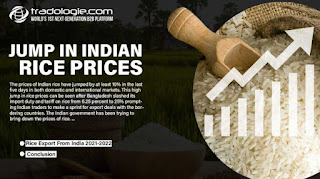Jump in Indian Rice Prices
The prices of Indian rice have jumped by at least 10% in the
last five days in both domestic and international markets. This high jump in
rice prices can be seen after Bangladesh slashed its import duty and tariff on
rice from 6.25 percent to 25% prompting Indian traders to make a sprint for export
deals with the bordering countries. The Indian government has been trying to
bring down the prices of rice.
Bangladesh
has given permission to import non-basmati rice until October 31. This is the
first time Bangladesh has started importing rice from India so early, as there
is a fear that India might put a ban on rice exports. Generally, Bangladesh
starts importing rice in September-October. There is a shortage of staples in
Bangladesh as the Russia-Ukraine war and India’s ban on wheat exports have
caused the drop in wheat imports, while floods have harmed rice.
BV
Krishna Rao, The president of the rice exporters association of India said that
the price of Indian non-basmati rice has risen in the last five days, from $350
per tonne to $360 per tonne. This happened after news came in from Bangladesh.
Bangladesh’s
rising wheat prices and declining imports have pushed up flour prices, putting
pressure on rice. Early floods, storms, and heavy rains have hampered rice
yields, sparking fears of further volatility in rice prices. Suraj Agarwal,
chief executive officer of Tirupati Agri Trade, said that prices for rice have
risen 10 percent and will continue to rise. Bangladesh buys rice from West
Bengal, Uttar Pradesh, and Bihar; in these three states, the price for common
rice has risen 20 percent. In other regions where it has risen 10 percent, this
increase has affected prices in those regions as well.
In
FY21, Bangladesh imported 13.59 lakh tonnes of rice. India had exported
non-basmati rice worth USD 6.11 billion in 2021-22 as compared to USD 4.8
billion in FY21. This showed that Bangladeshi consumers were interested in
Indian rice and would give a fresh fillip to Indian rice exports.
India
is the world’s biggest rice consumer after China, accounting for more than 40%
of the global trade in rice.
Rice
Export From India 2021-2022
Rice export from India is likely to reach 54.44
million tonnes (MT) in 2021-22, which is 4.7% higher than the current level of
52.95 MT. Rice exports are expected to rise by 5.6% per annum between 2021-22
and 2023-24, reaching an estimated 60.13 MT in 2023-24.
The
pace of growth will be slower than that of the previous year owing to lower
global rice production and increased domestic production due to the
government’s efforts to reduce its dependence on imports over the last couple
of years.
Rice
imports into India are also expected to decline slightly at 5% CAGR during
2021-2023 and reach 24.12 MT in 2020-21 from 23.9 MT in 2018-19 due to higher
domestic output, which is expected to be around 1 MT by the next year as
compared with 0.57 MT during 2018-19 period according to estimates by Rashtriya
Rice Research Institute (RRRI).
Conclusion
It’s important to note that a change in the price of rice is merely a symptom of an underlying shift in the economy: while people are consuming more and more rice, they are spending less and less on other commodities like wheat. Consumers have turned away from other staples because rice is perceived to be the most effective way to nourish the body for their daily needs. However, this isn’t a trend that’s been isolated to India — price volatility in food commodities has been on the rise throughout Asia.
Original Source: https://blog.tradologie.com/jump-in-indian-rice-prices/




Comments
Post a Comment